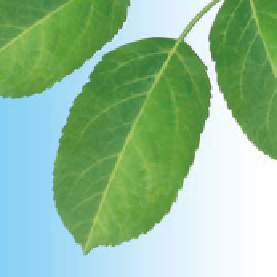Environmental Engineering Reference
In-Depth Information
this graph, what are nature's three most productive
and three least productive systems? Despite its low
NPP, so much open ocean is available that it produces
more of the earth's NPP per year than any other
ecosystem or life zone.
As we have seen, producers are the source of all
food in an ecosystem. Only the biomass represented
by NPP is available as food for consumers, and they
use only a portion of this amount. Thus,
the planet's
NPP ultimately limits the number of consumers (including
humans) that can survive on the earth.
This is an impor-
tant lesson from nature.
Peter Vitousek, Stuart Rojstaczer, and other ecolo-
gists estimate that humans now use, waste, or destroy
about 27% of the earth's total potential NPP and
10-55% of the NPP of the planet's terrestrial ecosys-
tems. They contend that this is the main reason why
we are crowding out or eliminating the habitats and
food supplies of other species. What might happen to
us and to other consumer species as the human popu-
lation grows over the next 40-50 years and per capita
consumption of resources such as food, timber, and
grassland rises sharply?
Heat
Heat
Tertiary
consumers
(human)
Decomposers
Heat
10
Secondary
consumers
(perch)
Heat
100
Primary
consumers
(zooplankton)
1,000
Heat
10,000
Usable energy
available at
each tropic level
(in kilocalories)
Producers
(phytoplankton)
Active Figure Figure 3-18
Natural capital:
generalized
pyra-
mid of energy flow
showing the decrease in usable energy
available at each succeeding trophic level in a food chain or
web. In nature, ecological efficiency varies from 2% to 40%,
with 10% efficiency being common. This model assumes a 10%
ecological efficiency (90% loss in usable energy to the environ-
ment, in the form of low-quality heat) with each transfer from
one trophic level to another.
See an animation based on this fig-
ure and take a short quiz on the concept.
Examine how energy flows among organisms at dif-
ferent trophic levels and across food webs in rain forests,
prairies, and other ecosystems at Environmental
ScienceNow.
phenomenon also explains why such species are usu-
ally the first to suffer when the ecosystems that support
them are disrupted, and why these species are so
vulnerable to extinction. Do you think humans are on
this list?
Sun
Productivity of Producers
Different ecosystems use solar energy to produce
and use biomass at different rates.
The
rate
at which an ecosystem's producers convert
solar energy into chemical energy as biomass is
the ecosystem's
gross primary productivity (GPP).
To stay alive, grow, and reproduce, an ecosystem's
producers must use some of the biomass they produce
for their own respiration.
Net primary productivity
(NPP)
is the
rate
at which producers use photo-
synthesis to store energy
minus
the
rate
at which they
use some of this stored energy through aerobic res-
piration, as shown in Figure 3-19. In other words,
NPP
Energy lost and
unavailable to
consumers
Respiration
Gross primary
production
Net primary
production
(energy
available to
consumers)
Growth and reproduction
R, where R is energy used in respira-
tion. NPP measures how fast producers can provide
the food needed by other organisms (consumers) in an
ecosystem.
Various ecosystems and life zones differ in their
NPP, as illustrated in Figure 3-20 (p. 50). According to
GPP
Figure 3-19
Distinction between gross primary productivity
and net primary productivity. A plant uses some of its GPP to
survive through respiration. The remaining energy is available to
consumers.














































